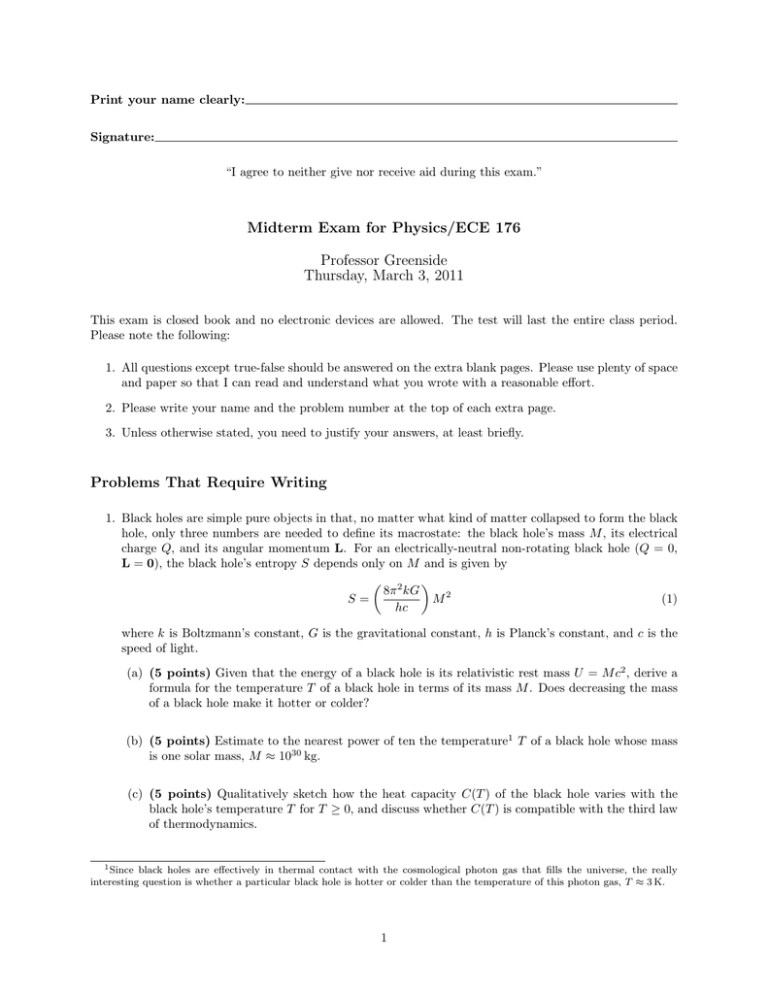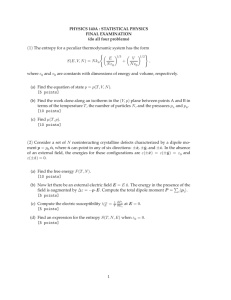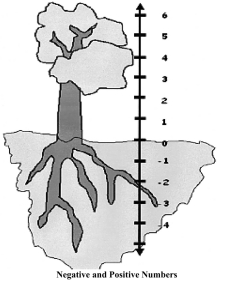Midterm Exam for Physics/ECE 176 Professor Greenside Thursday, March 3, 2011
advertisement

Print your name clearly: Signature: “I agree to neither give nor receive aid during this exam.” Midterm Exam for Physics/ECE 176 Professor Greenside Thursday, March 3, 2011 This exam is closed book and no electronic devices are allowed. The test will last the entire class period. Please note the following: 1. All questions except true-false should be answered on the extra blank pages. Please use plenty of space and paper so that I can read and understand what you wrote with a reasonable effort. 2. Please write your name and the problem number at the top of each extra page. 3. Unless otherwise stated, you need to justify your answers, at least briefly. Problems That Require Writing 1. Black holes are simple pure objects in that, no matter what kind of matter collapsed to form the black hole, only three numbers are needed to define its macrostate: the black hole’s mass M , its electrical charge Q, and its angular momentum L. For an electrically-neutral non-rotating black hole (Q = 0, L = 0), the black hole’s entropy S depends only on M and is given by 2 8π kG M2 (1) S= hc where k is Boltzmann’s constant, G is the gravitational constant, h is Planck’s constant, and c is the speed of light. (a) (5 points) Given that the energy of a black hole is its relativistic rest mass U = M c2 , derive a formula for the temperature T of a black hole in terms of its mass M . Does decreasing the mass of a black hole make it hotter or colder? (b) (5 points) Estimate to the nearest power of ten the temperature1 T of a black hole whose mass is one solar mass, M ≈ 1030 kg. (c) (5 points) Qualitatively sketch how the heat capacity C(T ) of the black hole varies with the black hole’s temperature T for T ≥ 0, and discuss whether C(T ) is compatible with the third law of thermodynamics. 1 Since black holes are effectively in thermal contact with the cosmological photon gas that fills the universe, the really interesting question is whether a particular black hole is hotter or colder than the temperature of this photon gas, T ≈ 3 K. 1 2. A kilogram of ice (T1 = 0◦ C) and a kilogram of boiling water (T2 = 100◦ C) at atmospheric pressure are mixed together in a thermally isolated container and allowed to come to thermodynamic equilibrium. (a) (5 points) To one significant digit, calculate the final temperature Tf in Celsius inside the container and describe what you will find in the container if you open it up. Note: The specific heat of water at constant pressure cP ≈ 4.2 × 103 J/(kg · K), and the latent heat of fusion (for converting ice to water) is L ≈ 3.4 × 105 J/kg. (b) (5 points) In terms of the quantities T1 , T2 , Tf , cP , and L, find a mathematical expression (which you do not have to evaluate numerically) for the total change in entropy of the ice-water mixture after the mixture has reached equilibrium. 3. (8 points) Draw the qualitative form of the temperature-dependence of the heat capacity, C(T )/(N k) vs kT /(µB), for a paramagnet consisting of N spin-1/2 magnetic dipoles of strength µ that has been placed in an homogeneous external magnetic field of magnitude B. Give the approximate numerical values on the horizontal and vertical axes for any interesting features of the curve, and explain whether your plot is consistent with the equipartition theorem. Note: this problem does not require any derivations or formulas. 4. (8 points) For x a real number whose magnitude is small and for constants a and b, find a second-order accurate approximation c0 + c1 x + c2 x2 to the expression 1 . 1 + exp (ax + bx2 ) (2) 5. The thermodynamic processes corresponding to a gasoline combustion engine can be roughly modeled by a so-called Otto cycle, which consists of the following four successive steps applied to air. (For this problem, you can think of air as an ideal gas consisting of diatomic nitrogen molecules that each have f degrees of freedom.) • step 1, adiabatic compression: The gas with initial values (V1 , P1 ) for the volume and pressure is compressed adiabatically by a piston to a smaller volume V2 < V1 so that the gas parameters are now (V2 , P2 ). • step 2, constant volume heating by combustion: The piston is then locked into place (which makes the volume of the gas constant) and an amount of heat Q0 > 0 is transferred to the gas by combustion of gasoline droplets mixed with the air. The heat increases the pressure to a new value P3 > P2 so that the gas parameters are now (V2 , P3 ). • step 3, adiabatic expansion: The piston is released and the gas now expands adiabatically, doing useful work, until the volume has return to the starting volume V1 . The gas parameters are now (V1 , P4 ). • step 4, constant volume cooling: the piston is again locked in place and the gas is cooled with constant volume until the state of the gas has returned to its starting value of (V1 , P1 ). Please answer the following questions: (a) (12 points) Draw the four steps of an Otto cycle on a P V diagram. On your plot i. shade the area that corresponds to the total work done during one cycle. ii. indicate with an arrow and label where the temperature of the gas is highest along the cycle. 2 iii. indicate with an arrow and label where the temperature of the gas is lowest along the cycle. iv. indicate with an arrow and label which of the four steps generates the most entropy. Note: you need to justify your answers briefly so that I understand that you understand how you got your answers. (b) (10 points) Given that the efficiency e of a heat engine is defined to be e= W , Qh (3) where W is the total work done by the system during one cycle and Qh is the total amount of heat that enters the system during one cycle, show for an Otto cycle that γ−1 V2 e=1− , (4) V1 where γ = (f + 2)/f is the adiabatic exponent (so γ − 1 = 2/f ). Increased efficiency therefore requires making the compression ratio V2 /V1 smaller; actual engines have a compression ratio of about 1/8. Hint: You can deduce P2 in terms of the given quantities V1 , V2 , and P1 from the relation P1 V1γ = P2 V2γ since step 1 is an adiabatic process. Next, figure out how to express P3 in terms of P2 , Q0 and V2 . Finally, calculate W for the entire cycle by evaluating an appropriate integral between V2 and V1 . (c) (5 points) By rewriting Eq. (4) in terms of the temperatures that occur at the start and end of step one, explain briefly why the Otto cycle does not attain the maximum possible efficiency allowed by the second law of thermodynamics e = 1 − Tc /Th , where Tc and Th are respectively the coldest and hottest temperatures that occur during the Otto cycle. 6. An important process in many areas of science and engineering is adsorption, the binding of a molecule to the surface of a substance. For many surfaces, a qualitatively useful model of adsorption is an “eggcarton” model in which the surface is assumed to be a set of uniformly spaced and identical concavities like an egg carton: The concavities are the locations where a molecule can adsorb. The egg carton model assumes that once a molecule adsorbs to the surface, it can not move around, and also that molecules do not interact with one another on the surface, so that adsorption of one molecule does not affect the adsorption of other molecules. (a) (5 points) The macrostate of a surface with adsorbed atoms can be characterized by the number N of adsorbed atoms while a microstate of the surface would be some particular arrangement of N atoms on the surface. Explain why the multiplicity Ω(N ) of a macrostate with N atoms is given by the expression M Ω(N ) = , (5) N where M is the total number of adsorption sites. 3 (b) (10 points) Assuming that M and N are large integers, use Stirling’s formula to obtain a simplified expression for the entropy S(N ) = k ln Ω(N ) and then obtain an expression for the chemical potential µsurface of adatoms on the surface. (c) (5 points) Assume that the two-dimensional system of adatoms is in thermodynamic equilibrium with a surrounding ideal gas of identical atoms whose temperature and pressure are T and P respectively. Given that the chemical potential of the surrounding gas is " 3/2 # kT 2πmkT µgas = −kT ln , (6) P h2 show that the surface density θ = N/M of adatoms (with 0 ≤ θ ≤ 1) is related to the pressure P of the surrounding gas by the expression: θ(P ) = P , P0 + P (7) where P0 = P0 (T ) is some combination of constants and of the temperature that has units of pressure. You should give the mathematical form of P0 explicitly. (d) (5 points) Sketch the curve θ vs P as given by Eq. (7) and indicate where the point corresponding to P = P0 lies on your curve. Discuss whether the values of θ make scientific sense in the limits of small and large gas pressures P . True or False Questions (2 points each) For each of the following statements, please circle T or F to indicate whether a given statement is true or false respectively. 1. T/ F It is possible for a liquid to have a negative temperature T . 2. T/ F Blowing on a hot marshmallow to cool it is an example of energy transfer by work. 3. T/ F Expanding an ideal gas always increases its entropy. 4. T/ F The magnetic field strength B is an extensive thermodynamic variable. 5. T / F It is possible for heat to be exchanged between two systems with different temperatures even if the systems are not in physical contact with one another. 6. T/ F During a quasistatic adiabatic process, the entropy does not change. 7. T/ F Compressing an ideal gas always increases its temperature. 8. T/ F the form For a large integer N 1, the Gaussian that approximates the function (xe−x ) Ae−N Bx , 2 where A and B are positive constants. 4 N will have (8) The following data and formulas may be useful: h ≈ 7 × 10−34 J · s, G ≈ 7 × 10−11 N · m2 /kg2 , dU = T dS − P dV + µ dN, C= S = k ln Ω, Q , ∆T CV = Q ∆S = , T ln(x!) ≈ x ln(x) − x, ∂U ∂T T V γ−1 = const, , CP = V Z T2 ∆S = T1 Z kT f = P V, U = Nf 2 2 ∆U = Q + W, P V γ = const, Tabsolute = −273◦ C. c ≈ 3 × 108 m/s, C(T ) dT, T 1 ex = exp(x) ≈ 1 + x + x2 , 2 Score: ∂U ∂T γ= +P P S = Nk 2. Problem 2: 3. Problem 3: 4. Problem 4: 5. Problem 5: 6. Problem 6: 7. True-false: Total points lost: 5 V2 P (V ) dV. V1 f +2 . f ∂V ∂T , P L= Q . m " 3/2 #! 5 V 4πm U + ln . 2 N 3h2 N 1 ≈ 1 − x + x2 , 1+x Grade: 1. Problem 1: W =− 1 ln(1 + x) ≈ x − x2 . 2





